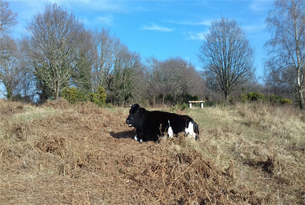Kinson Common
This nature reserve has a suprising number of habitats - which means plenty of different plants and animals
About Kinson Common
Kinson Common is a small relic of the once extensive heathland that covered most of southeast Dorset
Heathland owes its existence in large part to Neolithic farming activities some 5000 years ago. Tree felling and grazing by these farmers created extensive areas of open heathland, this habitat now supports a range of wildlife, someof which cannot survive anywhere else. For this reason, in 1988 Kinson Common was designated a Site of Special Scientific Interest.

Archaeology
The area is rich in archaeological evidenceIn 1927 Palaeolithic implements were found on the Common which are now housed in the British Museum.
Smaller flint implements from the Neolithic and Bronze Age have been found onthe surface of the Common, as on many other local heathlands.Two Bronze Age barrows are present just to the north of the cemetery. The eastern tumulus is an example of a fairly common and widespread bowl barrow, whereas the western tumulus is a saucer barrow, a much less common type.There are several boundary banks on the Common. These are shown on the1839 Kinson Tithe Map and may date back to the 18th century or even earlier. A good example of these can befound surrounding the lowest part of the common, separating the higher land from the central bog area.

Wildlife
Conservation grazing
Left to nature, the heathland and bogs would revert to woodland.Therefore, it is necessary to control invasive scrub (birch, gorse,willow and bramble).

In 2005 British rare breed cattle were introduced to maintain, in asensitive way, the open areas of dry heath, wet heath and grassland, these traditional hardy breeds thrive on heathland. They particularly enjoy eating the new growth on young willow trees inthe spring.The cattle use their tongues to pull tufts of vegetation into their mouths and trample dense areas ofbramble opening up gaps in the vegetation, which inturn provides opportunities for wild flowers, insects and reptiles to move in.
Birds
Kinson Common is an important nesting andfeeding area for several bird species. The largest is the buzzard which can often be seen soaring high above scanning the open ground for small mammals or reptiles.Look out for the tree creeper which lives up to its name as it circumnavigates tree trunks looking for hidden insects.Our resident species are joined in thesummer by migrants such as willow warbler, reed warbler and whitethroat.Others use the Common for overwintering, such as snipe.

Reptiles
Heathland is the perfect habitat for reptiles and two of Britain’s six native species of reptile can be seen here common lizards and slow worms. Although they are shy and difficult to spot, they can sometimes be seen basking in the early morning sun.

Insects
On a hot summers day, the Common is alive with insects. The wet areas provide the perfect breeding habitat for 12 different species of dragonfly and damselfly including the aptly named beautiful demoiselle.The uncommon bog bush cricket lives here and the distinctive Roesel’s bush cricket is a more recent arrival to the Common.The nationally scarce and formidable raft spider can be seen here around the bog pools.

Plant life
Although Kinson Common is a small area, it has a rich variety of habitats.The poor acid soil of the dry heathland only supports a fewspecially adapted species such as common and bell heather, commonand dwarf gorse andthe grass, bristlebent. Wet heath on the otherhand is rich in plant species and can be found in the low-lying bog in the centre of the Common. Look out for the tussocky purplemoor grass, cross-leaved heath and deergrass.Two types of fascinating insect eating plants are found here, sundew and pale butterwort along with three different kinds of orchid: southern marsh, early marsh and heath spotted.
